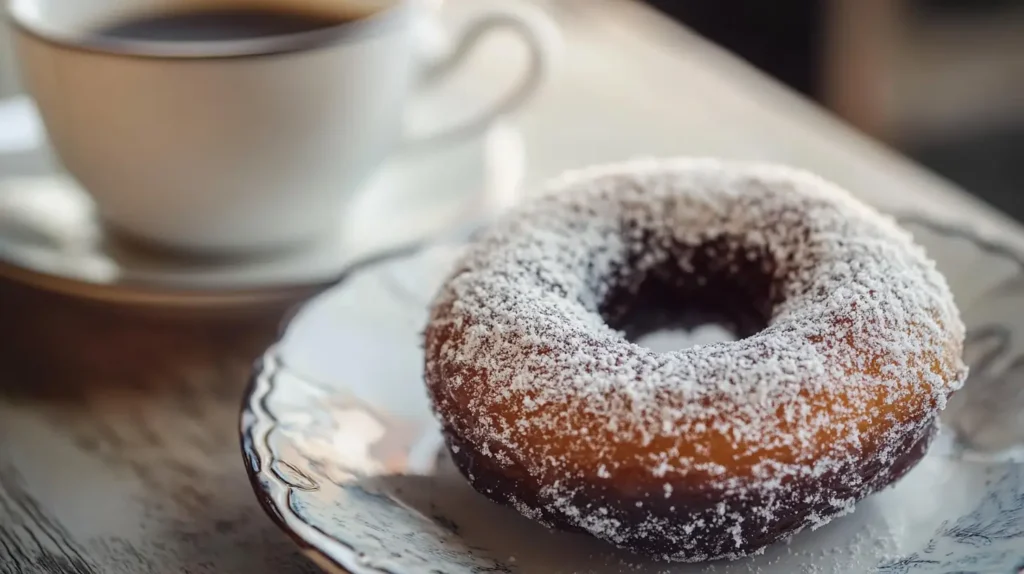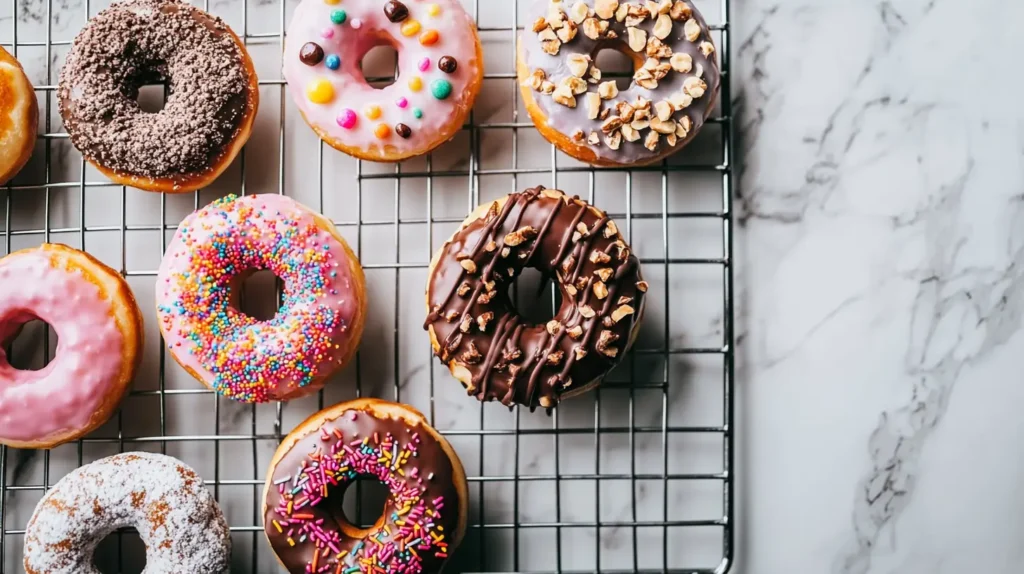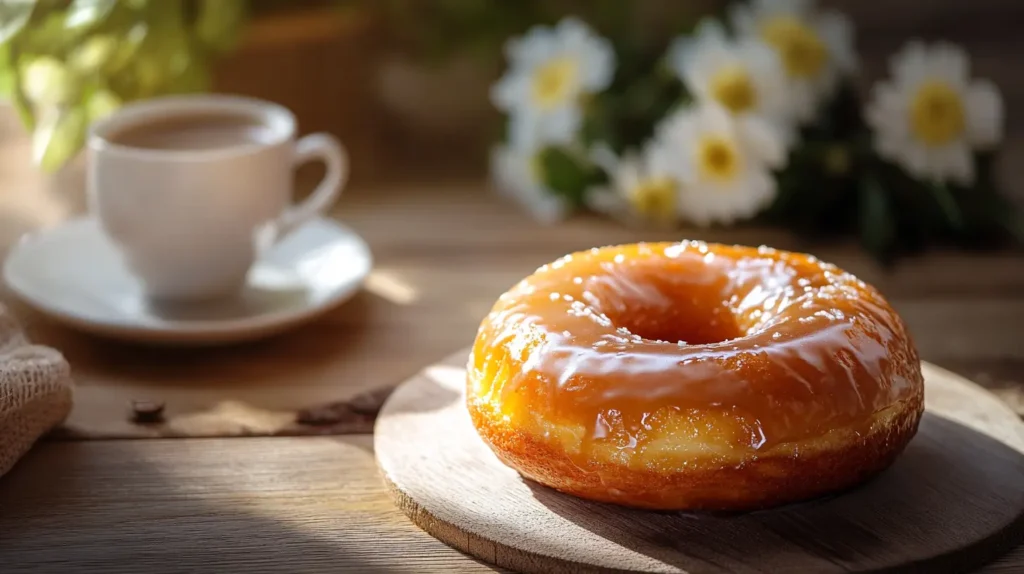Biting into one of these treats brings back memories of weekend mornings with my grandmother. The crisp exterior and dense, crumbly interior make them more than just pastries—they’re edible nostalgia.
Unlike yeast donuts, this denser variety offers a satisfying bite that 35% of enthusiasts prefer. With roots in Dutch “olykoeks,” they showcase a simple yet precise approach to baking, turning basic ingredients into something extraordinary.
Whether you’re a fan or a first-timer, their versatility with glazes and toppings makes these donuts a true culinary art form, perfect for savoring.
Table of Contents
Understanding the Fundamental Difference Between Cake and Yeast Donuts
Exploring donut flavors reveals two main types: the dense and crumbly variety versus the light and airy kind. Each offers a unique taste and preparation process, making them special in the world of bakery delights.
The Science of Leavening Agents
The main difference is how they rise. Cake donuts use baking powder for a dense texture. On the other hand, yeast donuts use fermentation for a light, airy feel.
- Cake donuts: Chemical leavening, quick preparation
- Yeast donuts: Biological fermentation, longer proofing time
- Texture differences: Compact vs. fluffy
Historical Evolution of Donut Types
The history of these treats is interesting. Cake donuts started in the 1830s with new leavening tech. Yeast donuts came from Dutch immigrants, showing the traditional way.
Chemical Composition Comparison
The composition of these two types of donuts reveals big differences. The denser variety contains more butter for a richer taste, while yeast-based ones are lighter with a subtle, fermented flavor.
“The beauty of donuts lies not just in their taste, but in the intricate science behind their creation.” – Pastry Chef Anonymous
| Characteristic | Cake Donuts | Yeast Donuts |
|---|---|---|
| Preparation Time | 30 minutes | 1-2 hours |
| Texture | Dense, crisp | Light, puffy |
| Average Calories | 300-450 | 200-300 |
Knowing these differences makes you see donuts as more than just treats. It turns your bakery visit into a journey of discovery.
The Dense and Satisfying Texture of These Donuts
What makes these treats special is their dense, satisfying texture, setting them apart from other pastries. Their preparation and ingredients are key to this uniqueness.
Fried at 350-375°F, they develop a golden-brown exterior while staying soft and tender inside—a true delight with every bite.
“A cake donut is not just a pastry, it’s an experience of texture and flavor.” – Pastry Chef Anonymous
Key Characteristics of Cake Donuts
- Denser texture compared to yeast donuts
- Crispy exterior with a soft, cake-like center
- Quick frying process (1-2 minutes per side)
- Higher oil absorption due to dense composition
Cake donuts are perfect for satisfying your donut cravings. They are made with baking powder or baking soda. This makes them denser than yeast donuts.
| Characteristic | Cake Donuts | Yeast Donuts |
|---|---|---|
| Texture | Dense and firm | Light and airy |
| Frying Time | 1-2 minutes | 1-2 minutes |
| Leavening Agent | Baking powder | Yeast |
The magic of cake donuts is in their satisfying texture. Each bite is rich and fulfilling. This makes them a favorite among donut lovers.
Superior Coffee Dunking Experience

Cake donuts are the perfect match for your morning coffee. They turn dunking into a special art that makes breakfast better.
Their dry texture makes them ideal for soaking up liquid without falling apart, adding magic to any coffee lover’s morning. It’s like a sweet treat that holds its shape while getting full of coffee flavor.
Optimal Dunking Techniques
Learn to dunk donuts like a pro with these tips:
- Hold the donut for 2-3 seconds in hot coffee
- Dunk at a slight angle to prevent complete submersion
- Choose coffee temperature around 160-170°F for best results
Moisture Absorption Properties
Cake donuts are amazing at soaking up liquid without falling apart. Their dense crumb structure keeps them soft but still holds together.
Temperature and Texture Interaction
“The magic happens when hot coffee meets a cool cake donut” – Pastry Chef Marcus Rodriguez
When hot coffee meets a cake donut, something special happens. The outside gets a bit soft, but the inside stays tender. It turns your coffee break into a fancy treat.
The Art of Cake Donut Making Process
Making cake donuts is an art that needs both skill and creativity. Unlike other pastries, cake donuts use a special batter. This makes them unique in the world of fried treats.
The magic starts with knowing the right ingredients and methods. Here’s what you need to do:
- Measure dry ingredients carefully, including flour and baking powder
- Combine wet ingredients to create a smooth, consistent batter
- Mix ingredients minimally to prevent tough texture
- Use precise temperature control during frying
“The secret to perfect cake donuts lies in the delicate balance of ingredients and technique.”
Starting your baking journey means paying close attention to details. Common baking mistakes can affect texture by up to 40%. Avoid overmixing to prevent dense, less tasty donuts.
Experts say to use about 1 to 1.5 teaspoons of baking powder per cup of flour. This ensures the donuts are light and fluffy, making them irresistible.
With more people wanting creative and beautiful desserts, learning to make cake donuts is key. About 75% of customers love desserts that look and taste new and exciting.
Cake Donut Taste, Why Donuts Are Popular, Sweet Treats
Donuts have won the hearts of many across America. Cake donuts are a favorite for their special texture and taste. They stand out among bakery treats.
The taste of cake donuts is a mix of sweetness and density. This makes them different from other pastries. Cake donuts are more filling and enjoyable to eat than yeast donuts.
Flavor Profile Analysis
Cake donuts offer a mix of flavors and textures that people love. Their dense and crumbly feel is unique and appealing.
- Rich, buttery flavor
- Crispy exterior
- Soft, tender interior
- Versatile flavor options
Consumer Preferences
People love cake donuts for good reasons. Their strong flavor and satisfying texture make them a favorite treat.
“We won’t sell it if it doesn’t taste good!” – Kelly Brewer
Market Trends
| Donut Type | Market Popularity | Key Characteristics |
|---|---|---|
| Classic Cake Donut | High | Dense texture, versatile flavors |
| Gluten-Free Cake Donut | Growing | Dietary restriction friendly |
| Seasonal Flavor Cake Donut | Trending | Apple cider, pumpkin variations |
The donut market keeps changing, but cake donuts stay popular. They offer both classic and new flavors. These treats are a hit for anyone looking for a sweet bakery experience.
How Baking Powder Creates the Perfect Crumb Structure
Baking powder is the secret to making donuts extra special. It turns simple cake donuts into light, fluffy treats. These treats have a texture that’s hard to resist.
When baking powder is activated, it starts a chemical reaction. This reaction makes cake donuts unique. The powder creates tiny air bubbles in the dough. This makes the donuts tender and soft.
“The magic of baking powder is in its ability to create microscopic air pockets that deliver the perfect donut texture.”
Here’s how baking powder works its magic:
- Releases carbon dioxide gas when mixed with liquid
- Creates tiny air bubbles in the donut batter
- Provides a light and airy internal structure
- Ensures consistent rise during baking
Baking powder gives cake donuts a denser texture. This texture is perfect for holding glazes and frostings. It keeps the donuts stable and delicious.
Professional bakers know the secret. The right amount of baking powder makes donuts unforgettable. It’s why people keep coming back for more.
Glazing and Topping Possibilities for Cake Donuts

Cake donuts are a blank canvas for creativity, turning simple treats into sweet wonders. They offer a chance to explore beyond traditional glazing, opening up a world of flavors.
Discovering cake donut toppings reveals a wide range of options to enhance your baking. The classic glaze is a favorite, adding a sweet touch that highlights the donut’s texture.
Traditional Glazing Methods
Traditional glazing uses a sugar-based coating that hardens when cooled. You can make this with:
- Vanilla glaze
- Chocolate glaze
- Maple-flavored coating
- Classic white sugar glaze
Modern Topping Innovations
Modern bakers have introduced new and exciting flavors. Now, your donuts can have:
- Fruit-infused glazes
- Savory-sweet combinations
- Exotic spice blends
- Artisan chocolate drizzles
“A great glaze can transform an ordinary cake donut into an extraordinary culinary experience.” – Pastry Chef Recommendation
With just 7-8 minutes of baking, you can make glazed treats that wow everyone. Cake donuts are versatile, offering a topping for every taste.
The Role of Temperature in Cake Donut Preparation
Mastering the art of fried pastries requires precision, and temperature control is key. Cake donuts need careful heat attention. The magic happens when you keep the oil temperature between 340°F and 350°F.
Temperature is crucial for the perfect texture in cake donuts. At this range, you get:
- Complete cooking of the donut’s center
- Prevention of exterior burning
- Achieving a golden-brown crispy exterior
- Maintaining optimal moisture inside
“Precision is the secret ingredient in creating exceptional fried pastries.” – Professional Baker
To get consistent results, use a reliable kitchen thermometer. The right temperature gives your donuts a crisp exterior and a soft, tender interior.
| Temperature Range | Donut Characteristic |
|---|---|
| 340°F – 350°F | Ideal Frying Zone |
| Below 340°F | Soggy, Oil-Logged Donuts |
| Above 350°F | Burnt Exterior, Undercooked Center |
Pro tip: Always let your donuts rest on paper towels after frying to absorb excess oil and maintain that perfect texture.
Nutritional Comparison Between Cake and Yeast Donuts
When you’re craving donuts, knowing the difference between cake and yeast donuts is key. These treats might look alike, but they’re not the same in terms of nutrition.
Cake donuts usually have more calories than yeast donuts. Here are some important nutritional facts:
- Dunkin’s plain cake donut: 310 calories
- Krispy Kreme’s plain donut: 290 calories
- Estimated average for plain donuts: 300 calories
The way they’re made affects their nutrition. Cake donuts soak up more oil, which means more calories and fat.
| Donut Type | Calories | Fat (g) | Carbs (g) | Protein (g) |
|---|---|---|---|---|
| Cake Donut | 300 | 19 | 34 | 3 |
| Yeast Donut | 215 | 11 | 22 | 4 |
Note: Nutritional values can vary by brand and specific recipe.
“Donuts are a treat, not a meal replacement. Enjoy in moderation!” – Nutrition Expert
Donuts are treats, not healthy foods. Knowing their nutritional content helps you enjoy them in a balanced way.
Regional Preferences and Cultural Impact
Cake donuts are a big hit in American food culture. They come in many flavors, showing off local tastes and traditions. This tasty pastry has grown from a simple breakfast item to a symbol of culture.
East Coast vs. West Coast Donut Preferences
The East and West Coasts have different donut tastes. On the East Coast, people love:
- Classic glazed cake donuts
- Dense, traditional donuts
- Simpler flavors
On the West Coast, donut fans go for something different:
- Artisanal and gourmet donuts
- Unique flavors
- Donuts that look good on Instagram
International Cake Donut Variations
The world’s donut market is huge, worth USD 14.1 billion in 2023. Countries have their own special cake donuts:
| Region | Unique Donut Characteristics |
|---|---|
| Japan | Matcha-flavored cake donuts with simple designs |
| Brazil | Donuts with coconut and condensed milk |
| India | Donuts with cardamom and saffron |
North America eats the most donuts, over 10 billion a year. The donut market here is expected to hit USD 23.4 billion by 2032.
“Donuts are more than food—they show local creativity and love for sweets.”
Storage and Freshness Benefits of Cake Donuts
Keeping cake donuts fresh is key. The right storage can make them last longer. This way, you can enjoy them for a while.
Cake donuts stay fresh for 5 to 6 days when stored right. They’re perfect for those who love donuts.
Best Storage Practices
- Store in an airtight container at room temperature
- Keep away from direct sunlight and heat sources
- Avoid refrigeration, which can dry out the donut
Freezing is great for longer storage. Plain or lightly glazed cake donuts freeze exceptionally well. You can enjoy them for up to 3 months.
Freezing and Thawing Tips
- Wrap individual donuts in wax paper
- Place in a large freezer bag
- Thaw at room temperature or use microwave (10-15 seconds)
“A well-stored donut is a delicious donut!” – Pastry Chef Wisdom
| Storage Method | Freshness Duration |
|---|---|
| Room Temperature (Airtight) | 5-6 Days |
| Freezer | Up to 3 Months |
Cream-filled donuts need extra care. They shouldn’t sit at room temperature for more than 2 hours. This prevents them from spoiling.
FAQ
What makes cake donuts different from yeast donuts?
Cake donuts use baking powder, which makes them dense and crumbly with a crispy outside. They are more like a cake and quicker to make. This gives them a unique taste and texture compared to yeast donuts.
Are cake donuts healthier than other types of donuts?
Cake donuts are not a health food but might be a bit healthier than yeast donuts. They are less greasy and have fewer calories. But, they should still be enjoyed in moderation as part of a balanced diet.
What’s the best way to enjoy a cake donut with coffee?
Cake donuts are great for dunking. Dip them briefly in hot coffee to enhance the flavor. Their sturdy texture makes them perfect for this ritual.
How long do cake donuts stay fresh?
Cake donuts stay fresh for 1-2 days in an airtight container. Keep them away from humidity and sunlight. If they get stale, warming them in the oven can revive their texture.
Can I make cake donuts at home?
Yes, you can make cake donuts at home. You’ll need flour, sugar, baking powder, eggs, and milk. Fry them at 340-350°F and mix well for the right texture.
What are some popular cake donut flavors?
Popular flavors include vanilla, chocolate, and old-fashioned. Modern flavors include maple, apple cider, and matcha. You can also find savory-sweet options. Glazes and toppings range from sugar to chocolate and fruit designs.
Why do cake donuts have a crispier exterior?
The Maillard reaction during frying makes cake donuts crispy. The sugars and proteins on the surface caramelize, creating a golden crust. This process gives them a unique texture and flavor.
Conclusion
Your journey into the world of cake donuts shows why they’re loved across the United States. These treats are more than just pastries; they’re a mix of history and new ideas. Their dense texture and wide range of flavors make them a favorite for many.
Donuts’ popularity isn’t just about sugar. Their baking method makes them lighter and more appealing. Dunkin’ Donuts and Krispy Kreme have helped make them a big part of American food culture.
Exploring local bakeries or trying homemade recipes shows the variety of cake donuts. You can find everything from classic cinnamon sugar to gourmet toppings. Cake donuts are more than breakfast; they’re about comfort, creativity, and tradition.
Enjoying cake donuts is more than a trend. It’s celebrating a treat that keeps getting better. Dive into their rich flavors, try new things, and cherish their place in American food history.

